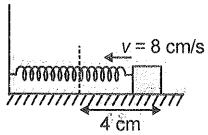The function represents:
1. An SHM with a period of
2. An SHM with a period of
3. A periodic motion but not SHM with a period of
4. A periodic motion but not SHM with a period of
Values of the acceleration A of a particle moving in simple harmonic motion as a function of its displacement x are given below
16 8 0 8 -16
x (mm) 4 -2 0 2 4
The period of the motion is :
1.
2.
3.
4.
The acceleration-time graph of a particle undergoing SHM is shown in the figure. Then,
| 1. | the velocity of the particle at point 2 is zero |
| 2. | velocity at point 3 is zero |
| 3. | velocity at point 2 is +ve and maximum |
| 4. | both (2) & (3) |
| 1. | maybe \(K_0\) |
| 2. | must be \(K_0\) |
| 3. | maybe more than \(K_{0}\) |
| 4. | both (1) and (3) |
A body of mass M is situated in a potential field. The potential energy of the body is given by ; where x is position, K and are constant. Period of small oscillations of the body will be:
1.
2.
3.
4.
A particle is executing SHM about origin along X-axis, between points A(, 0) and B(-, 0). Its time period of oscillation is T. The magnitude of its acceleration second after the particle reaches point A will be
1.
2.
3.
4.
A particle executes linear oscillation such that its epoch is zero. The ratio of the magnitude of its displacement in 1st second and 2nd second is (Time period = 12 seconds)
1.
2.
3.
4.
A block of mass 0.02 kg is connected with spring and is free to oscillate on a horizontal smooth surface as shown. The angular frequency of oscillation is 2 rad . The block is pulled by 4 cm (from equilibrium position) and then pushed towards the spring with a velocity of 8 cm/s. The amplitude of oscillation is (Neglect any damping)

1.
2.
3.
4. 1 cm
A particle moves on a circular path with uniform speed about the origin. The \((x-t)\) graph will be:
(\(x:\) value of \(x-\)coordinate; \(t-\)time)
| 1. |  |
2. |  |
| 3. |  |
4. |  |
A simple pendulum has time period \(T.\) The bob is given negative charge and surface below it is given a positive charge. The new time period will be:
1. less than \(T\)
2. greater than \(T\)
3. equal to \(T\)
4. infinite







